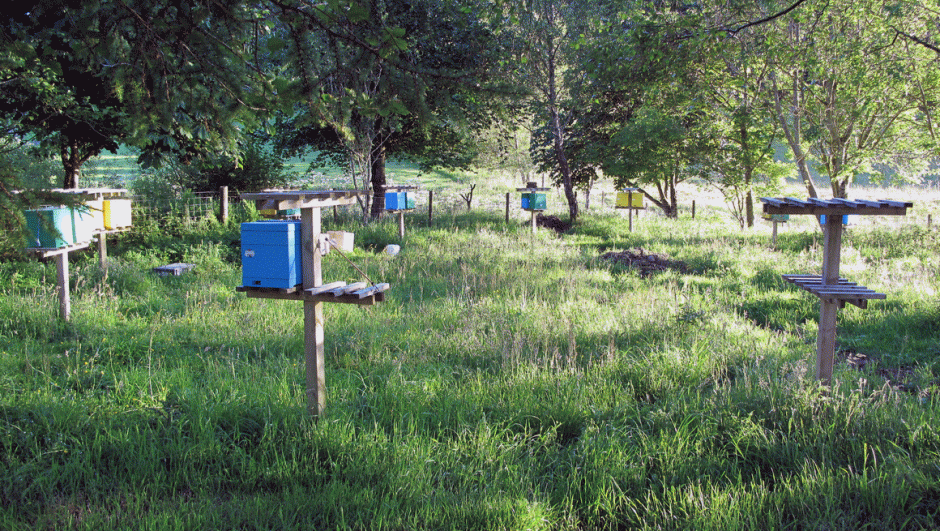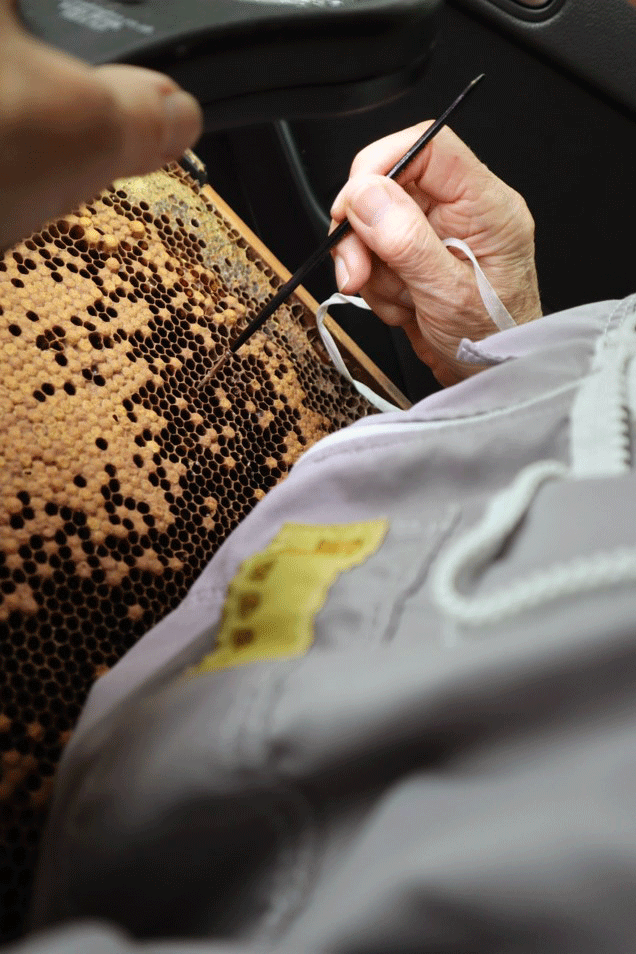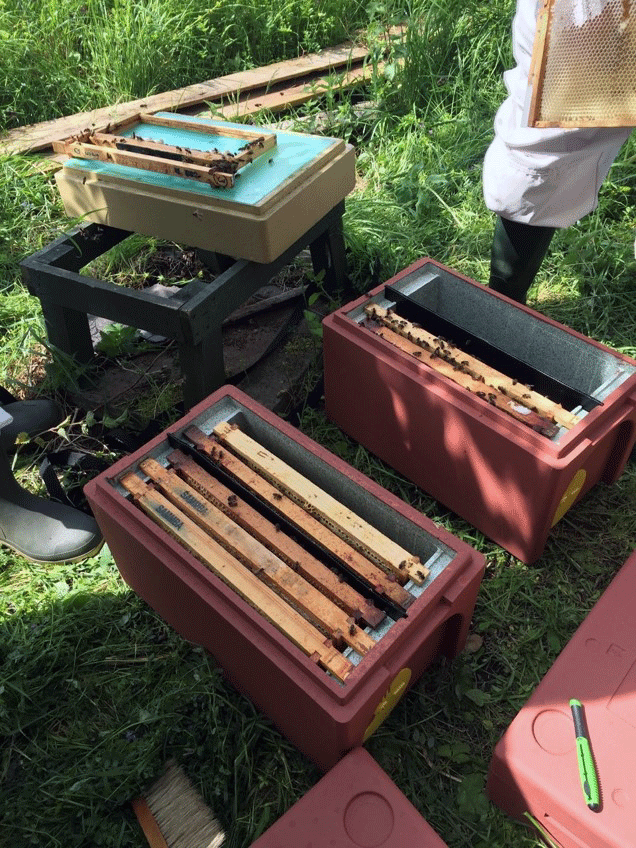Pathways to success
Why have a queen rearing and breeding group?
Breeding groups form a vital part of the work of the Scottish Native Honey Bee Society. They work well by pooling their expertise, sharing equipment and having access to larger numbers of good locally adapted stocks. Although groups show differences in their organisation reflecting local circumstances and preferences some features are likely to be shared.
The positive aspects of local queen rearing and selection are:
- Elimination of the importation of bees and less chance of unwanted pests and diseases
- using locally adapted bees which are likely to perform better
- creating good strains of more suitable and manageable bees for your area
- reducing the risks of incompatible out-crossings with other races of bees which can lead to deterioration in behaviour
- enhancing beekeeper skills and involvement in assessing and selection of future breeding lines.
- The inclusion of local beekeepers in a cooperative way gives a sense of belonging and achievement which could have many benefits for the future.
Group ethos
Enthusiasm and a belief in using good Scottish dark native strains of bees are an essential. Make contacts beyond your local association and preferably keep this as a separate group. Maintain good relations and accept that others may wish to keep different bees. Concentrate on creating manageable local strains that are productive and docile. Allow others to share in your eventual success and even trial your queens heading new colonies to win over friends and spreads desirable genes around your area.
Group organisation
Once your group has acquired core members and is ready to start practical work a schedule of meetings and a coordinator should be chosen to ensure smooth running. No advanced beekeeping skills are required for this position, but it should be someone who can engender a cooperative working spirit and communicate well. Small closed groups can work with minimal records of meetings where individuals know one another well, agree on almost everything and speak frequently but how often does this happen? As the group enlarges it will be necessary to formalise records of meetings and discussions. There are then more likely to be detailed plans for group aspirations and management of finances so good records will need to be kept. Furthermore, mechanisms for the turnover of key roles, especially leadership and the maintenance of consensus, will assist the long-term health of such groups.
Key members should have good beekeeping skills and someone with reasonable queen rearing skills. They should be prepared to work with less skilled members and to impart their knowledge in order to raise the level of expertise of the whole group. Everyone needs to participate if they are to share the queens that are produced.
And don’t forget the bees!
You may be lucky and already in a remote rural area where there are few beekeepers and group members have native or near native dark bees which have been selected over several years. Many groups will be starting from next to nothing and see their best option is to bring in good native nucs or mated queens from established native bee breeders. Be prepared to join a waiting list though.
Think carefully about what might be available in your association area. Does anyone remember older beekeepers who are perhaps rarely seen now that there are so many ‘new faces’ at association meetings? Were they known for having good manageable colonies, probably even dark bees? Did they rarely have swarming problems or have a reputation for never buying bees in from outside the area? Ask acquaintances about stray swarms they have seen recently. Let association members know what it is you are looking for in these bees and direct them to the SNHBS website for guidance in identifying native honey bees.
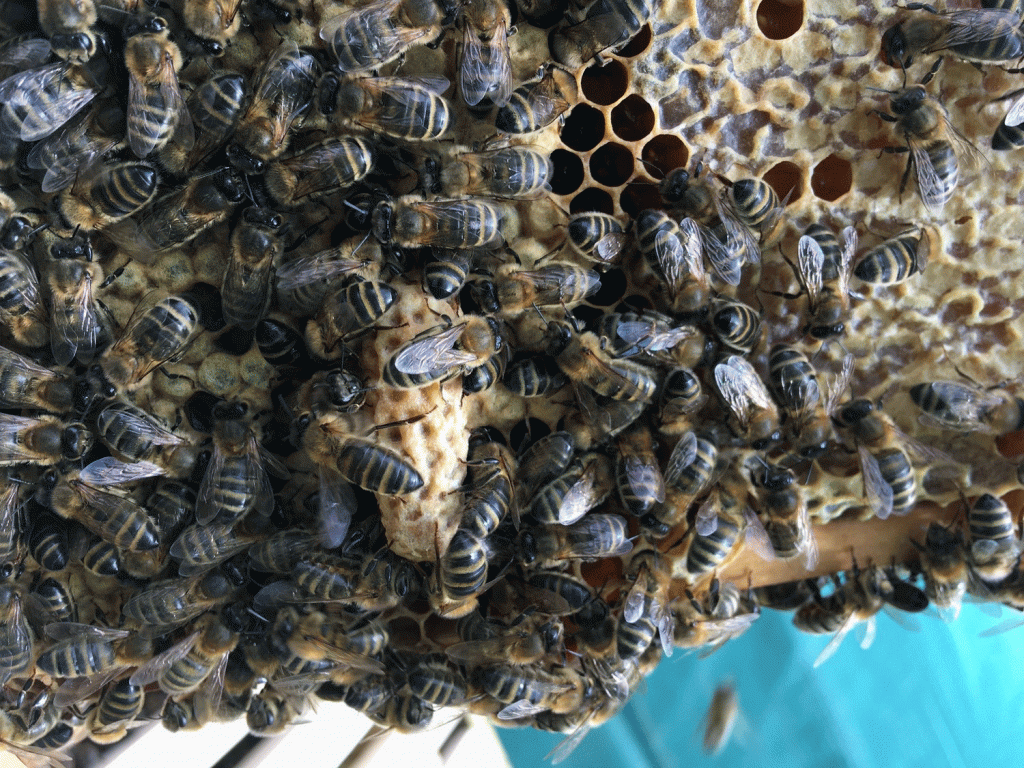
Stray swarm late summer 2018 with supersedure cell late spring 2019.
Photo: Naomi Kenny
This is a stray swarm which arrived in a new beekeeper’s apiary in the previous year very late in the summer. This suggests it could be a late swarming native type of bee. They were docile when manipulated, had good stores of honey and 3 queen cells which had the characteristics of supersedure cells. Their body colouring was uniformly dark and the tomental bands on the abdomen were narrow. When you find colonies like this it is worth further assessment. If you are not sure why not ask the SNHBS team of assessors if they are likely to be suitable for inclusion in a breeding and assessment program? See Scoring hairs and tomenta …
New groups may decide to follow quite different lines of action depending on their circumstances. Those able to establish remote mating apiary sites may opt for obtaining and propagating pure strains of dark native bees while others will work with the best they can get or ‘near native types’ concentrating on selecting good behavioural characteristics and perhaps an ability to cope with Varroa. Remember that it is easy to lose potentially good breeding material or overlook useful colonies of your own. I recall what I call a ‘survivor’ colony retrieved from a BT junction box in the ground which had been in residence probably two or three years and now has the original queen in one hive, a daughter mated locally in another and one mated in a remote mating apiary with dark bee drones. This promises to be an interesting assessment for next season. One further important consideration is to maintain sufficient genetic diversity in any population used. Exchanging breeding material with other breeding groups may help maintain diversity.
Choosing the group apiary site
Individual group members are likely to have their own apiary sites sometimes far apart but when closer together and with few other beekeepers around there is the possibility of flooding an area with desirable drones and including others in a cooperative venture. Surprisingly good results for within-strain mating can result but it is hard work and requires group effort. Group members may visit apiaries to assess their bees for breeding purposes on a number of features especially their dark bee characteristics. Members with their own apiaries are often in quite different types of locations so are ideally placed to assess new queens under different conditions heading colonies the following year.
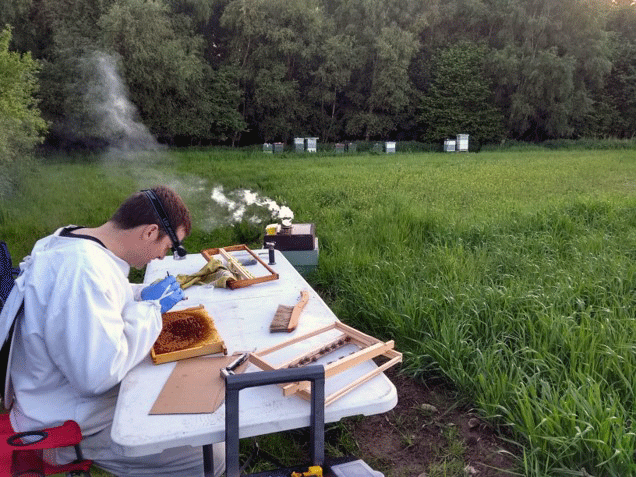
North East SNHBS Group
Grafting session in progress. This can be done simply and without specialised equipment.
Photo: Ewan Campbell
Cheviot Bee Breeding Group
Left: Grafting very young larvae using a ‘000’ sable paint brush
Right: Using BS Honey 2 in 1 poly nucs with three frames per side.
Photos: Justine Sweeney
A group may opt for a remote mating apiary that is maintained during the active season for queen rearing and mating only. This may be at the head of a valley or in hill areas with chosen drone rearing colonies brought into the area. There will need to be sufficient drone colonies to cover for the number of mating nucs likely to be there and maintain genetic diversity in the population. The positioning of these colonies should be well away from the mating nucs with drone colonies placed further down the valley and guarding the entrance, in effect ‘flooding’ the area with chosen drones. Virgin queens may travel several kilometres, but drones will be more restricted as they consume energy patrolling possible congregation areas and need to return to hives to ‘refuel’. More intimate knowledge of the geographical location may help to identify drone congregation areas. Virgin queens and drones are likely to fly towards a dip in the horizon on mating flights. A surprising number of matings may also occur within the apiary vicinity depending on weather conditions. It is likely that most of the matings will be within six kilometres.
Where special care is taken to establish a remote or isolated mating area for Amm drone matings only then any mini-nucs brought there should not contain drones. This requires care in making up the mini-nucs and can be done by using bees only from supers above queen excluders or filtering out drones using wired excluder screens when shaking bees from frames.
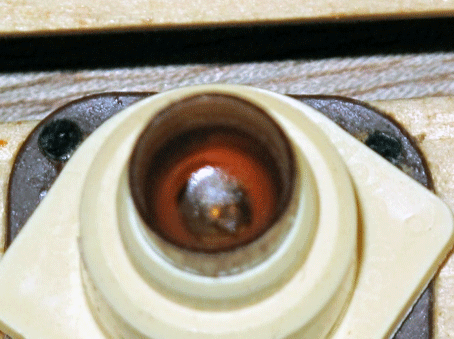
Larva in cup 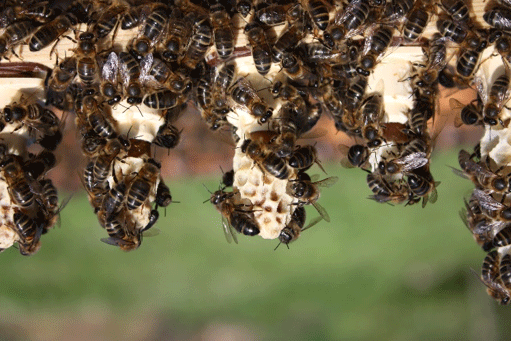
Cell bar with capped queen cells
Photos: John Durkacz (left) and Gavin Ramsay (right)
What equipment will you need?
The more expensive items will be where a new group opts to purchase good representative colonies of Scottish Amm bees to launch their breeding programme. If members already have suitable colonies then work can be started quickly at minimal cost by simply borrowing these colonies for grafting, queen rearing and provision of drones. Either Jenter Cupkit or direct grafting systems can be used to reliably produce reasonable numbers of queen cells of the same age. Grafting is probably the better way to go as the skills required are easily learned and at least one person in a group will master this quickly. When starting out it is best to stay with what you are familiar with.
Why not consider an application to our SAMMBA Fund?
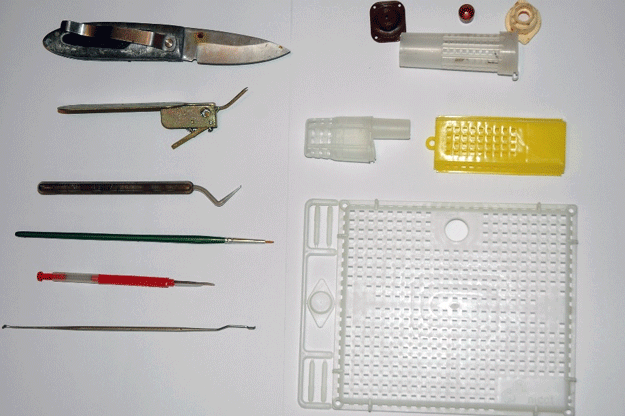
Various items useful for cell grafting on left side of photo.
Nicot cup and holder – top right
Various types of queen introduction cages and a press-in cage on the lower right.
The simplest method of grafting larvae is the ‘000’ brush.
Photo: Jeff Baxter
Preparation and use of mini-nucs
Apideas are great for getting new queens mated quickly and are economic in their use of bees. They do however need some care and regular checks and skills with their management. Bees are best taken from supers above queen excluders which ensures they are mostly young bees without drones. This is especially important if you are taking them to a remote mating site where you have selected drone rearing colonies.
There are other suitable versions of the smaller mating nucs and then the mini-pluses which have more bees and can maintain themselves for longer periods.
It is possible to use full size nucs based on 2 or 3 BS frames where only a few queen cells are available. These units are more easily looked after.
Mininucs can be expensive to purchase for a group so perhaps individuals should supply their own. It is possible to construct modified supers for production hives where mini-frames can be fitted for drawing out and even have their own resident bees that can be transferred. However, many prefer to start afresh each spring with thoroughly cleaned mini-nucs and fresh wax foundation starter strips.
Virgin queens can be added to newly made up mini-nucs which are often then kept in the dark for two days before being placed out in the mating apiary in the evening. As newly mated queens come into lay and queens are removed for introduction elsewhere then new mature cells or other virgins can be added provided certain precautions are followed.
Arrange the mating nucs in such a way as to reduce the chances of virgins returning from mating flights and entering the wrong mini-nuc. Having shade also helps to prevent bees absconding from these small units in hot weather.
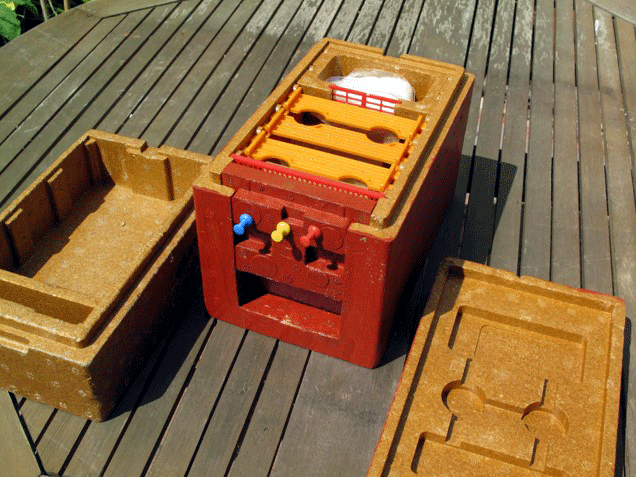
Apideas 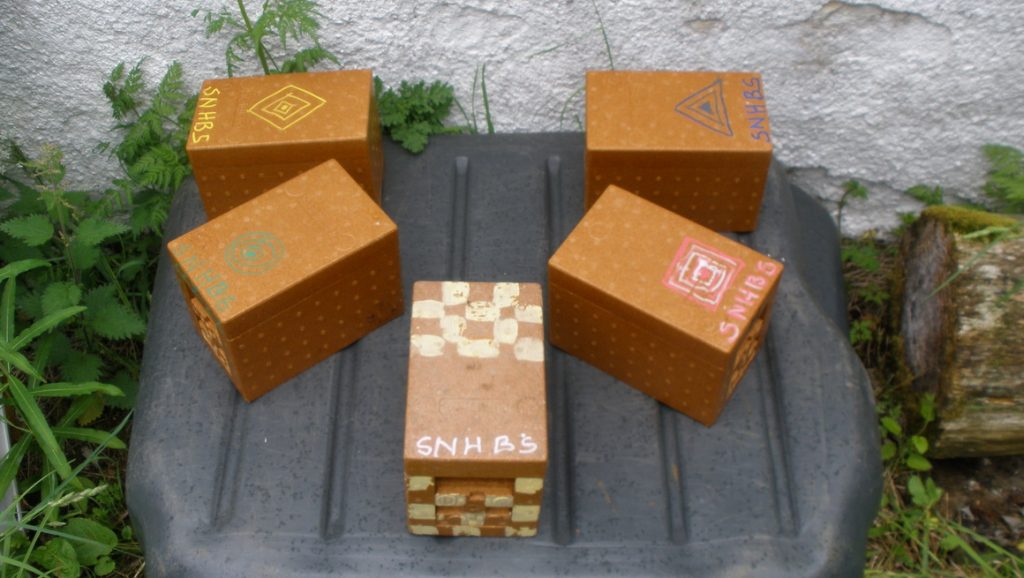
Photos: John Durkacz (left) and North East SNHBS Group (right)
Queen rearing plans and skills required
Individuals or small groups aiming to rear limited numbers of queens, perhaps just for group members, can use simple methods. Whatever method you choose make it something you are familiar with and has given good results in the past. The skills for the different parts of procedures can often be learned quickly, for example, grafting very young larvae. Managing powerful colonies as cell raisers requires good general beekeeper abilities. Overseeing the plan for rearing larger numbers of queens and choosing good breeding stocks requires higher skill levels and coordination of activities.
Timetables for rearing queens
Preparation early in the season should consider the need for mature drones flying ready for emerging queens. If you plan to establish a remote mating apiary then it may be in a hill area perhaps at the head of a valley where good drone producing colonies will need to be established at least two weeks earlier to have mature drones flying before bringing in mating nucs. As drone colonies attempt to requeen themselves through the season or if they decline in strength, they may need to be replaced by fresh colonies to maintain a supply of fertile drones. The timetable below shows some of the important timings that should be followed for success.
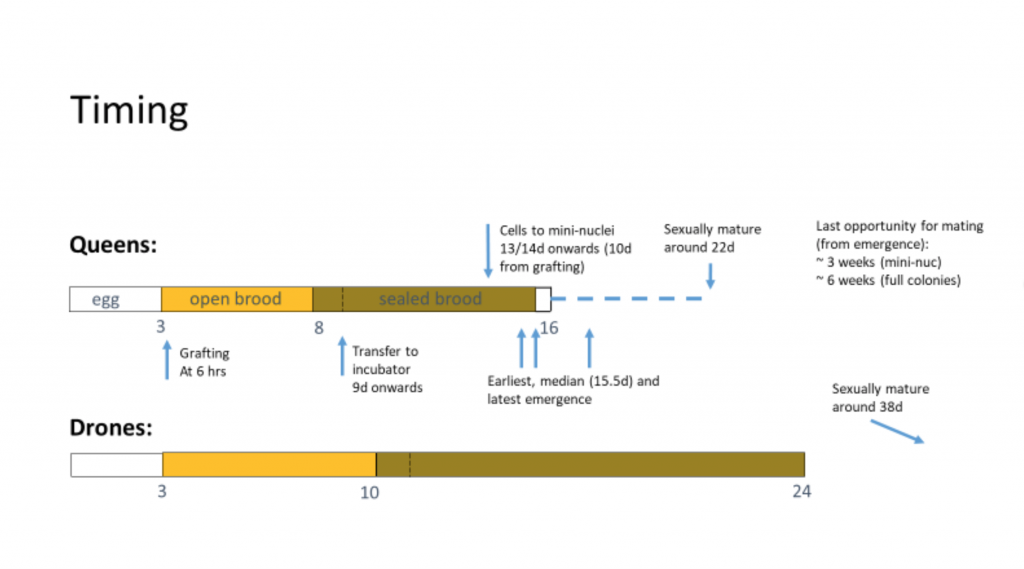
Remote mating apiaries may well have later spring /summer development and foraging sources correspondingly delayed so that colonies for drone rearing need special care. Varroa levels in these drone production colonies will require monitoring as the encouragement of drone production allows a rapid build-up of Varroa populations.
There are many methods of raising cells but good timing and prosperous colonies for cell raising are essential. Methods involving de-queening can make powerful colonies more difficult to manage and require careful checking for any ‘wild’ emergency cell removal at least once around six days. Such colonies can be topped up with emerging brood to extend the time when they have a high population of young bees essential for cell raising. The queen-right cell raiser method favoured by the National Bee Unit is an excellent system to learn, can be repeated through the season and allows for more stability of the colony.
Most failures of queen cell raising are due to:
- the stock having a virgin queen in residence in a supposedly queenless colony;
- for the first six days being able to make queens from its own larvae; or
- an insufficiency of young bees, pollen or nectar or syrup income.
Grafting or other methods
For producing larger numbers of queens then grafting is the way to go. Skills are easily learned and immensely satisfying when successful. Jenter cupkit systems work very well for some. Colonies preparing to swarm can be used easily and if there are good queen cells already there, they can easily be used provided that the colony traits are desirable and they are not from ‘swarmy’ stock. Using a system of grafting, as an example, the diagram above on timing shows when grafting is done and the subsequent removal days for completed queen cells and introduction to mating nucs. Straightforward if the group opts for just a few batches of completed cells each season, more complicated if several different batches are running at the same time. Keeping a careful diary of activities then becomes essential.
Distributing new queens
Once mated queens are ready you need somewhere to use them to good effect. Where so much care and attention has been given, they should not be wasted. You will probably find that the group will require all the queens they can produce for their own members in the first two to three years. Requeening of poorly performing colonies and heading nucs requires good planning and knowledge of the principles of safe queen introduction. Then comes the important step of assessing the performance of these new queens. More experienced beekeepers are often best placed to make a dispassionate assessment of performance, docility, disease resistance and so on.
Selecting your bees
SNHBS has produced guidelines on assessment of native bee characteristics available from the website (Honey bee ID: Resources, Identifying Native Bees, and Scoring Hairs and Tomenta).
The larger the number of colonies the group has available to select from the better. For longer term work about 35-50 colonies will give a sufficiently diverse genetic background for selection. This does not mean you need to own these colonies but are able to access suitable colonies which are locally adapted or colonies from other areas with the desired characteristics. Grafted frames can easily be transported, and queen rearing colonies can be in any members’ apiary. Again, this requires good record keeping.
Choosing native bees
Bees well adapted to your locality and present there for many years may be suitable for inclusion in a breeding programme provided they are docile and are near native in appearance. They should be relatively free of chalkbrood and be productive. If they have a lower incidence of swarming and tend to swarm later in the season or even supersede more readily so much the better. Starting with good native queens will give an excellent base especially if the group has an isolated mating apiary. Drone-producing colonies are equally important and several will be required for each group of mini-nucs on site. Even if you can only access virgin queens from a suitable source, they will still produce the ‘right’ drones for your apiary if mated with local stock as the genes of the drones will be the same as the original mother.
Risks of inbreeding
It is tempting to begin a breeding programme with only a very small number of stocks highly selected for desirable traits. This generally leads to poor stocks within a couple of years due to inbreeding in general and at the csd gene in particular. The solution is to relax the stringency of selection and maintain a larger pool of material contributing virgins and drones or to swap mated queens or other breeding stock of different lineage with other groups if biosecurity concerns allow. It is useful to know that genetic ‘bottlenecking’ is severe when mated queens produce drones (a maximum of two variants of each gene get transmitted to all drones produced by one queen) but is much less severe when mated queens produce virgins (all the diversity from the sperm in her spermatheca may get transmitted to a set of daughter queens).
Methods of evaluation
Desirable traits could be docility, disease resistance, good wintering ability, productivity. The group will need to decide what are to be their priorities preferably keeping these to a minimum in the first instance. Other important considerations for the future might include Varroa tolerant behaviour which introduces a new set of assessment skills for the group.
After the initial group set-up they will need to assess overall features of the colonies as two or more identifiable lines may be developed which could lead to other possibilities with ‘crossing’ to make even more vigorous stocks. By making a start with a uniform strain of dark bee with native characteristics it is likely to be easier to ‘fix’ desirable characteristics more quickly and avoid the deleterious effects of an ‘unplanned free for all’ of outcrossings.
Forming a viable group and getting results is hard work but satisfying. This is a long-term venture so is not for the faint-hearted!
References
Scottish Native Honey Bee Society
Scottish SBAi forum
Native Irish Honey Bee Society
Bee Breeding and Bee Improvement Association
Books
The Principles of Bee Improvement: Jo Widdicombe from Northern Bee Books
The Dark European Honey Bee: Ruttner, Milner, Dews
Mating in Miniature: Mӧbus
Breeding Better Bees (using simple modern methods): Dews & Milner from Northern Bee Books
Breeding Techiniques and Selection for Breeding of the Honeybee: F Ruttner trans. Ashleigh and Eric Milner from BIBBA
PDF Download: SNHBS Queen Rearing Groups
Header photo: Cloverlea remote mating site
© Scottish Native Honey Bee Society 2020

